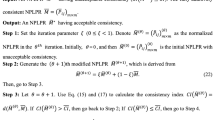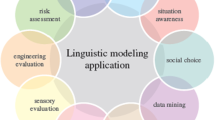Abstract
As one of the burgeoning decision-making instruments, the integrity of dual probabilistic linguistic term sets (DPLTSs) is to express the decision information in terms of cognitive certainty and uncertainty. The superiority of correlation coefficient is to demonstrate the interrelationship of the variables. This paper aims to give full play to the advantages of the above two. Firstly, it defines the dual probabilistic linguistic correlation coefficient. Then, it is based on the proposed entropy for DPLTSs calculates the comprehensive weight vector. Moreover, combined with the proposed correlation coefficient, it further defines the weighted correlation coefficient as a measure for the application about artificial intelligence. Besides, it uses the dual probabilistic linguistic closeness coefficient as the reference to compare the pros and cons. Finally, a specific numeric simulation is utilized to demonstrate the feasibility of the two different measures.

Similar content being viewed by others
Explore related subjects
Discover the latest articles, news and stories from top researchers in related subjects.References
Agrawal A, Gans JS, Goldfarb A (2018) Economic policy for artificial intelligence. In: Nber Chapters. https://ssrn.com/abstract=3194842
Cabrerizo FJ, Al-Hmouz R, Morfeq A, Balamash AS et al (2017) Soft consensus measures in group decision making using unbalanced fuzzy linguistic information. Soft Comput 21(11):3037–3050
Chen J (2017) The integration of technology and ethics: on the human culture of artificial intelligence technology. Academics Social Sciences in China Press, New York
Chen SM, Tsai BH (2015) Autocratic decision making using group recommendations based on the OWA operator and correlation coefficients. Inf Sci 290:106–119
Chen L, Wang YZ (2003) Research on TOPSIS integrated evaluation and decision method based on entropy coefficient. Control Decis 18:456–459
Chen YF, Peng XD, Guan GH, Jiang HD (2014) Approaches to multiple attribute decision making based on the correlation coefficient with dual hesitant fuzzy information. J Intell Fuzzy Syst 26(5):2547–2556
Coelho F, Braga AP, Verleysen M (2010) Multi-objective semi-supervised feature selection and model selection based on Pearson’s correlation coefficient, In: Iberoamerican congress conference on progress in pattern recognition, image analysis, computer vision, and applications. Springer, Heidelberg, vol 6419, pp 509–516
Cogger K, Yu P (1985) Eigenweight vectors and least-distance approximation for revealed preference in pairwise weight ratios. J Optim Theory Appl 46(4):483–491
Dong GP, Kwun YC, Jin HP, Park IY (2009) Correlation coefficient of interval-valued intuitionistic fuzzy sets and its application to multiple attribute group decision making problems. Math Comput Modell Int J 50(9):1279–1293
Dong YC, Zhang HJ, Herrera-Viedma E (2016) Integrating experts’ weights generated dynamically into the consensus reaching process and its applications in managing non-cooperative behaviors. Decis Support Syst 84:1–15
Egidi M (2018) Paths in contemporary economics and sciences of artificial intelligence that originate from Simon’s bounded rationality approach. Soc Sci Electron Publ 70(279):7–33
Falie D, David L (2012) New correlation coefficient for data analysis. Sci Pap 12(4):51–54
Fan WJ, Liu JN, Zhu SW, Pardalos PM (2018) Investigating the impacting factors for the healthcare professionals to adopt artificial intelligence-based medical diagnosis support system (AIMDSS). Ann Oper Res. https://doi.org/10.1007/s10479-018-2818-y
Farhadinia B (2013) Correlation for dual hesitant fuzzy sets and dual interval-valued hesitant fuzzy sets. Int J Intell Syst 29(2):184–205
Farhadinia B, Herrera-Viedma E (2017) Entropy measures for hesitant fuzzy linguistic term sets using the concept of interval-transformed hesitant fuzzy elements. Int J Fuzzy Syst 2:1–13
Gadanidis G (2017) Artificial intelligence, computational thinking, and mathematics education. Int J Inf Learn Technol 34(2):133–139
García-Alonso CR, Arenas-Arroyo E, Pérez-Alcalá GM (2012) A macro-economic model to forecast remittances based on Monte-Carlo simulation and artificial intelligence. Expert Syst Appl 39(9):7929–7937
Gillan C, Harnett N, Milne E et al (2018) Professional implications of introducing artificial intelligence in healthcare: an evaluation using radiation medicine as a testing ground. J Med Imaging Radiat Sci 49(1):S1–S2
Heinen N, Heuer A, Schautschick P (2017) Artificial intelligence and human labour: implications for companies and economic policy. Wirtschaftsdienst 97(10):714–720
Johnson WL, Valente A (2009) Tactical language and culture training systems: using artificial intelligence to teach foreign languages and cultures, In: National conference on innovative applications of artificial intelligence, AAAI Press, vol 3, 1632–1639
Li CC, Dong YC, Herrera F, Herrera-Viedma E et al (2017) Personalized individual semantics in computing with words for supporting linguistic group decision making. Appl Consens Reach Inf Fusion 33(1):29–40
Liao HC, Xu ZS, Zeng XJ (2015) Qualitative decision making with correlation coefficients of hesitant fuzzy linguistic term sets. Knowl Based Syst 76(1):127–138
Liao HC, Zhang C, Luo L (2018) A multiple attribute group decision making method based on two novel intuitionistic multiplicative distance measures. Inf Sci 467:766–783
Lin MW, Xu ZS, Zhai YL, Yao ZQ (2018) Multi-attribute group decision-making under probabilistic uncertain linguistic environment. J Oper Res Soc 69(2):157–170
Liu ST, Kao C (2002) Fuzzy measures for correlation coefficient of fuzzy numbers. Fuzzy Sets Syst 128(2):267–275
Liu PD, Teng F (2018) Some Muirhead mean operators for probabilistic linguistic term sets and their applications to multiple attribute decision-making. Appl Soft Comput 68:396–431
Liu YT, Dong YC, Liang H, Chiclana F, Herrera-Viedma E (2018) Multiple attribute strategic weight manipulation with minimum cost in a group decision making context with interval attribute weights information. IEEE Trans Syst Man Cybern 49(10):1981–1992
Luo YQ, Xia JB, Chen TP (2009) Comparison of objective weight determination methods in network performance evaluation. J Comput Appl 10:48–49
Malik M, Bashir Z, Rashid T, Ali J (2018) Probabilistic hesitant intuitionistic linguistic term sets in multi-attribute group decision making. Symmetry 10(9):392. https://doi.org/10.3390/sym10090392
Mao XB, Wu M, Shang N (2018) The multi-attribute group decision making model based on probabilistic linguistic correlation coefficient. J Jiangxi Normal Univ (Nat Sci Edn) 3:267–274
Mcarthur D, Lewis M, Bishary M (2005) The roles of artificial intelligence in education: current progress and future prospects. J Educ Technol 1:42–80
Meng XM, Hu HP (2009) Application of set pair analysis model based on entropy weight to comprehensive evaluation of water quality. J Hydraul Eng 3:257–262
Meng FY, Wang C, Chen XH, Zhang Q (2015) Correlation coefficients of interval-valued hesitant fuzzy sets and their application based on the shapley function. Int J Intell Syst 31(1):17–43
Morente-Molinera JA, Pérez IJ, Ureña MR, Herrera-Viedma E (2015) On multi-granular fuzzy linguistic modelling in group decision making problems: a systematic review and future trends. Knowl-Based Syst 74:49–60
Pang Q, Wang H, Xu ZS (2016) Probabilistic linguistic term sets in multi-attribute group decision making. Inf Sci 369:128–143
Qi Y, Wen F, Wang K, Li L, Singh S (2010) A fuzzy comprehensive evaluation and entropy weight decision-making based method for power network structure assessment. Int J Eng Sci Technol 2:92–99
Saaty TL (1978) Modeling unstructured decision problems—the theory of analytical hierarchies. Math Comput Simul 20:147–158
Saen RF, Memariani A, Lotfi FH (2005) The effect of correlation coefficient among multiple input vectors on the efficiency mean in data envelopment analysis. Appl Math Comput 162(2):503–521
Shan S (2016) A correlation-based subspace analysis for data confidentiality and classification as utility in CPS. In: 2016 IEEE conference on communications and network security (CNS), IEEE (2016), pp 426–431
Sun GD, Guan X, Yi X, Zhou Z (2018) An innovative TOPSIS approach based on hesitant fuzzy correlation coefficient and its applications. Appl Soft Comput 68:249–267
Tyagi SK (2015) Correlation coefficient of dual hesitant fuzzy sets and its applications. Appl Math Model 39(22):7082–7092
Wang Z (2018) The impact of artificial intelligence on industrial development. In: Modern Management Science, vol 4, pp 58–60
Wang ZX, Li J (2017) Correlation coefficients of probabilistic hesitant fuzzy elements and their applications to evaluation of the alternatives. Symmetry 9(11):259. https://doi.org/10.3390/sym9110259
Wang YM, Fan ZP, Hua Z (2007) A Chi square method for obtaining a priority vector from multiplicative and fuzzy preference relations. Eur J Oper Res 182:356–366
Wu XL, Liao HC (2018) An approach to quality function deployment based on probabilistic linguistic term sets and ORESTE method for multi-expert multi-criteria decision making. Inf Fusion 43:13–26
Xie WY, Xu ZS, Ren ZL (2017) Dual probabilistic linguistic term set and its application on multi-criteria group decision making problems. In: 2017 IEEE international conference on Industrial Engineering and Engineering Management (IEEM), IEEE, pp 1469–1474
Xie WY, Xu ZS, Ren ZL, Wang H (2018) Probabilistic linguistic analytic hierarchy process and its application on the performance assessment of Xiongan new area. Int J Inf Technol Decis Mak 17(6):1693–1724
Xu ZS (2012) Linguistic preference relations. In: Linguistic decision making. Springer, Berlin, pp 87–175
Xu ZS, Wang H (2017) On the syntax and semantics of virtual linguistic terms for information fusion in decision making. Inf Fusion 34:43–48
Yang MS, Lin WQ (2012) A weighted correlation coefficient control chart pattern recognition system. In: International conference on mechanic automation and control engineering, IEEE Computer Society (2012), pp 1135–1138
Yang JH, Yang MS (2005) A control chart pattern recognition system using a statistical correlation coefficient method. Comput Ind Eng 48(2):205–221
Ye J (2010) Fuzzy decision-making method based on the weighted correlation coefficient under intuitionistic fuzzy environment. Eur J Oper Res 205:202–204
Ye J (2013) Multi-criteria decision-making method using the correlation coefficient under single-valued neutrosophic environment. Int J Gen Syst 42(4):386–394
Ye J (2014) Correlation coefficient of dual hesitant fuzzy sets and its application to multiple attribute decision making. Appl Math Model 38(2):659–666
Yoon DM, Kim KJ (2017) Challenges and opportunities in game artificial intelligence education using angry birds. IEEE Access 3:793–804
Zhang H, Mao H (2009) Comparison of four methods for deciding objective weights of features for classifying stored-grain insects based on extension theory. Trans Chin Soc Agric Eng 25:132–136
Zhang YJ, Yang LJ (2014) A research using correlation coefficient to make Bayesian classification data mining. Appl Mech Mater 631–632:18–22
Zhang HY, Ji P, Wang JQ, Chen XH (2015) An improved weighted correlation coefficient based on integrated weight for interval neutrosophic sets and its application in multi-criteria decision-making problems. Int J Comput Intell Syst 8(6):1027–1043
Zhang YX, Xu ZS, Wang H, Liao HC (2016) Consistency-based risk assessment with probabilistic linguistic preference relation. Appl Soft Comput 49:817–833
Zhang YX, Xu ZS, Liao HC (2018) Water security evaluation based on the TODIM method with probabilistic linguistic term sets. Soft Comput. https://doi.org/10.1007/s00500-018-3276-9
Zhao N, Xu ZS (2015) Entropy measures for dual hesitant fuzzy information. In: International conference on communication systems and network technologies, IEEE, pp 1152–1156
Zou ZH, Yun Y, Sun JN (2006) Entropy method for determination of weight of evaluating indicators in fuzzy synthetic evaluation for water quality assessment. J Environ Sci 18:1020–1023
Acknowledgements
This work was supported by the Scientific Research Foundation of Graduate School of Southeast University (No. YBJJ1832), the FEDER financial support from the Project TIN2016-75850-R, and the Postgraduate Research and Practice Innovation Program of Jiangsu Province (No. KYCX18_0199).
Author information
Authors and Affiliations
Corresponding authors
Ethics declarations
Conflict of interest
The authors declare that they have no known competing financial interests or personal relationships that could have appeared to influence the work reported in this paper.
Additional information
Communicated by V. Loia.
Publisher's Note
Springer Nature remains neutral with regard to jurisdictional claims in published maps and institutional affiliations.
Rights and permissions
About this article
Cite this article
Xie, W., Xu, Z., Ren, Z. et al. The probe for the weighted dual probabilistic linguistic correlation coefficient to invest an artificial intelligence project. Soft Comput 24, 15389–15408 (2020). https://doi.org/10.1007/s00500-020-04873-0
Published:
Issue Date:
DOI: https://doi.org/10.1007/s00500-020-04873-0




